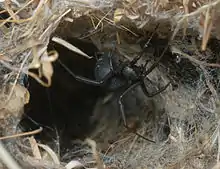Latrodectus indistinctus
Latrodectus indistinctus is a species of spiders in the family Theridiidae, found in Namibia and South Africa.[1] It is one of six species of Latrodectus found in southern Africa, four of which, including L. indistinctus, are known as black button or black widow spiders. Like all Latrodectus species, L. indistinctus has a neurotoxic venom. It acts on nerve endings, causing the very unpleasant symptoms of latrodectism when humans are bitten.[2]
| Latrodectus indistinctus | |
|---|---|
 | |
| Scientific classification | |
| Kingdom: | Animalia |
| Phylum: | Arthropoda |
| Subphylum: | Chelicerata |
| Class: | Arachnida |
| Order: | Araneae |
| Infraorder: | Araneomorphae |
| Family: | Theridiidae |
| Genus: | Latrodectus |
| Species: | L. indistinctus |
| Binomial name | |
| Latrodectus indistinctus O. P-Cambridge, 1904[1] | |
Description and Behavior
Like all spiders in the genus Latrodectus, females are larger than males, this species grows up from 7 to 16 mm, and the males 2,5 to 5 mm,
In maturity. Most retain at least short red stripes radiating upward from the tip of the dorsal abdomen, just above (and often also ventral for0 the dies. This is a spider from the north, like many black widows, it is not aggressive, its defense method when it feels threatened, is drop to the ground and ''Play dead''. Their egg sacks are usually hung in bush vegetation, where prey is available nearby, which includes insects and arthropods, females will occasionally attack to defend their eggs. [3]
Habitat
Its distribution is limited in Namibia and South Africa, Found in habitats such as tangled bushes, uncut grass, tall vegetation in dry places, agricultural areas and forests.[4]
Venom
They have neurotoxins, popularly known as latrotoxins. in 15 minutes after the bite there is intense pain, burning sensation and swelling, with systemic effects occurring hours later, such as intense muscle pain and cramps, which appear in an hour. Other symptoms include anxiety, slurred speech, feeling sick, headaches, sweating and fever.[5] rapid pulse, increased blood pressure and tightness in the chest together with difficulty breathing are important symptoms, which are usually more dangerous for children and elderly people with cardiovascular and respiratory diseases.[6] a case that occurred in 2016, in south africa, in a 38-year-old man reported symptoms such as, intense muscle pain, erythema, stiffness at the location of the bite that radiated to the trunk, arm and neck, muscle spasms and mild tachycardia. [7]
References
- "Taxon details Latrodectus indistinctus O. Pickard-Cambridge, 1904", World Spider Catalog, Natural History Museum Bern, retrieved 2016-02-02
- Müller, G.J.; Wium, C.A.; Marks, C.J.; du Plessis, C.E.; Veale, D.J.H., "Spider bite in southern Africa: diagnosis and management", Continuing Medical Education, retrieved 2016-02-02
- https://www.acq.osd.mil/eie/afpmb/docs/lhd/venomous_animals_byspecies.pdf
- https://www.acq.osd.mil/eie/afpmb/docs/lhd/venomous_animals_byspecies.pdf
- https://www.acq.osd.mil/eie/afpmb/docs/lhd/venomous_animals_byspecies.pdf
- Muller, G. J.; Wium, C. A.; Marks, C.; Plessis, C. E. du; Veale, D. J. H. (2012-09-19). "Spider bite in southern Africa: diagnosis and management". Continuing Medical Education. 30 (10): 382–391. ISSN 2078-5143.
- Thomas, Teressa Sumy; Kemp, Alan; Roberg, Kim Pieton (2018-07-03). "Black widow spider bite in Johannesburg". Southern African Journal of Infectious Diseases. 33 (3): 86–88. doi:10.1080/23120053.2018.1453271. ISSN 2312-0053.